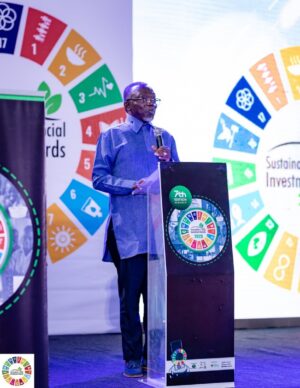University of Mines and Technology (UMaT), Vice-Chancellor Professor Richard Kwasi Amankwah, has stated that economic prosperity and environmental sustainability – a core component of the Environmental, Social and Governance (ESG) principles – share a positive relationship; as such, the two concepts must not be viewed as opposing forces but complementary elements of a thriving future.
Prof. Amankwah stressed that the traditional perception of economic growth at the expense of environmental well-being is not only unsustainable but also counterproductive. He argued that a healthy environment is not merely a luxury but a fundamental precondition for sustained economic development. “A degraded environment has far-reaching consequences for human health, productivity and overall economic stability,” the Vice-Chancellor said to B&FT on the 2023 Sustainability & Social Investment Awards’ (SSI) sidelines.
“Pollution, resource depletion and climate change pose significant threats to our economies, in both the short- and long-term,” he added at the event, which was held under the theme ‘Sustainability and the Economy: Building a Sustainable Future for All’. On the night, several corporate entities and individuals were honoured for leading the charge in championing sustainable and socially responsible practices within their communities.
The Vice-Chancellor’s remarks align with a growing global trend toward integrating environmental, social and governance (ESG) principles into investment and business practices.
According to recent estimates by Custom Market Insights, the projected compound annual growth rate (CAGR) for the global ESG investing market is 9.4 percent from 2023 to 2032. It is anticipated that the market will attain a valuation of US$46.5trillion by 2032, a development that analysts say demonstrates increasing recognition of financial and environmental performance interconnectedness.
In the context of sub-Saharan Africa, Prof. Amankwah noted the region’s immense potential for sustainable development; citing its rich natural resources, growing population and entrepreneurial spirit. However, he cautioned that this potential can only be fully realised by adopting a holistic approach that prioritises both economic growth and environmental protection.
“The future of sub-Saharan Africa lies in embracing sustainable development principles that align economic prosperity with environmental stewardship. By investing in renewable energy, sustainable agriculture and green technologies, we can create a future that is not only prosperous but also environmentally resilient.”
Prof. Amankwah’s call for a balanced approach to development resonates with the growing consensus among policymakers, businesses and civil society organisations that economic prosperity and environmental sustainability are not mutually exclusive but rather mutually reinforcing goals.

Chairman-Awarding Board, Sustainability and Social Investment (SSI) Awards, Professor Douglas Boateng – who is a leading expert in the field of strategic sourcing and ESGs, insisted that the insistence on sustainability is not a fad; arguing the growing investment opportunities represent a paradigm shift in how investors evaluate companies and assets. “It is no longer just about the profit and loss statements; it’s about how those profits are generated and distributed, and their broader impact on society and the planet,” he noted.
He stated that beyond environmental and social considerations, the enhanced scrutiny of companies’ governance structure and ethical standards will ensure improved efficiency and value for all.
Already, commentators are calling for the introduction of an Africa-focused ESG framework for assessing companies – owing to a number of factors which differentiate the region from the rest of the globe. These include having the world’s youngest population, with more than 60 percent of the continent’s population under the age of 25.
Additionally, the continent is responsible for less than five percent of global carbon emissions. For context, in 2021 global carbon dioxide emissions amounted to approximately 37.12 billion tonnes – with more than half of those emissions originating from the wealthiest 10 percent of the global population.
China leads as the largest emitter with 11.47 billion tonnes, followed by the United States (5 billion tonnes), India (2.7 billion tonnes), Russia (1.75 billion tonnes) and Japan (1.07 billion tonnes). Despite comprising around 17 percent of the world’s population, Africa’s carbon emissions are relatively modest, accounting for just 4 percent of the global total at 1.45 billion tonnes.
On a per capita basis, Africa stands out with the lowest emissions among all continents, averaging just 1 tonne of CO2 emitted per individual annually. In comparison, South America follows with 2.5 tonnes, Asia with 4.6 tonnes, Europe with 7.1 tonnes, Oceania with 10 tonnes, and North America with 10.3 tonnes. Consequently, the average American or Australian emits as much CO2 in a month as an individual in Africa does in an entire year.











